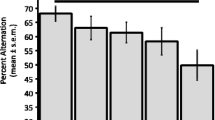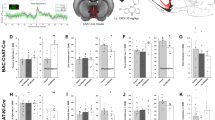Abstract
A series of experiments assessed the potential role of acetylcholine (ACh) in the escape interference produced by inescapable shock. Treatment with the anticholinesterase, physostigmine, succesfully mimicked the effects of inescapable shock. That is, the drug disrupted performance when escape was prevented for 6 s on any given trial, thereby necessitating sustained active responding. When escape was possible upon shock onset, the drug treatment did not influence performance. The centrally acting anticholinergic scopolamine hydrobromide antagonized the effects of physostigmine, and when administered prior to escape testing antagonized the disruptive effects of previously administered inescapable shock. In contrast, the peripherally acting agent scopolamine methylbromide did not influence the effects of these treatments, suggesting that the effects of physostigmine and inescapable shock involved central ACh changes. Scopolamine hydrobromide administered prior to inescapable shock did not prevent the escape interference from subsequently appearing, but this effect could not be attributed to state dependence. It was argued that the interference of escape following uncontrollable stress was due to nonassociative motor deficits. Alterations of the escape deficits by scopolamine were due to elimination of the motor disruption.
Similar content being viewed by others
References
Anisman H (1975) Time dependent variations in aversively motivated behaviors: nonassociative effects of cholinergic and catecholaminergic activity. Psychol Rev 82:359–385
Anisman H (1978) Neurochemical changes elicited by stress: behavioral correlates. In: Anisman H, Bignami G (eds) Psychopharmacology of aversively motivated behavior. Plenum, New York, pp 119–172
Anisman H, Skalar LS (1979) Catecholamine depletion upon reexposure to stress: Mediation of the escape deficits produced by inescapable shock. J Comp Physiol Psychol 93:610–725
Anisman H, deCatanzaro D, Remington G (1978) Escape performance following exposure to inescapable shock: deficits in motor response maintenance. J Exp Psychol [Anim Behav] 4:197–218
Anisman H, Pizzino A, Sklar LS (1980) Coping with stress, norepinephrine depletion and escape performance. Brain Res 191:583–588
Anisman H, Remington G, Sklar LS (1979) Effects of inescapable shock on subsequent escape performance: catecholaminergic and cholinergic mediation of response initiation and maintenance. Psychopharmacology 61:107–124
Anisman H, Suissa A, Sklar LS (1980) Escape deficits induced by uncontrollable stress: antagonism by dopamine and norepinephrine agonists. Behav Neurol Biol 28:34–47
Barry H, III (1978) Stimulus attributes of drugs. In: Anisman H, Bignami G (eds) Psychopharmacology of aversively motivated behavior. Plenum Press, New York, pp 455–485
Barrett RJ, Leith NJ, Ray OS (1972) Permanent facilitation of avoidance behavior by d-amphetamine and scoplamine. Psychopharmacologia 25:321–331
Bignami G (1976) Nonassociative explanations of behavioral changes induced by central cholinergic drugs. Acta Neurobiol Exp 36:5–90
Bignami G, Michatek H (1978) Cholinergic mechanisms and aversively motivated behaviors. In: Anisman H, Bignami G (eds) Psychopharmacology of aversively motivated behavior. Plenum Press, New York, pp 173–255
Carlton PL (1969) Brain-acetylcholine and inhibition. In: Tapp JT (ed) Reinforcement and behavior. Academic Press, New York, pp 286–237
Glazer HI, Weiss JM (1976a) Long-term and transitory interference effects. J Exp Psychol [Anim Behav] 2:191–201
Glazer HI, Weiss JM (1976a) Long-term interference effect: an alternative to “Learned Helplessness”. J Exp Psychol [Anim Behav] 2:202–213
Glazer HI, Weiss JM, Pohorecky LA, Miller NE (1975) Monoamines as mediators of avoidance-escape behavior. Psychosom Med 2:202–213
Karczmar AG, Scudder CL, Richardson DL (1973) Interdisciplinary approach to the study of behavior in related mice types. In: Ehrenpreis S, Kopin JJ (eds) Chemical approaches to brain function. Academic Press, New York, pp 160–254
Kobayashi RM, Palkovits M, Kizer JS, Jacobowitz DM, Kopin IJ (1976) Selective alterations of catecholamines and tyrosine hydroxylase activity in the hypothalamus following acute and chronic stress. In: Usdin E, Kvetnansky R, Kopin IJ (eds) Catecholamines and stress. Pergamon Press, Oxford, pp 29–38
Maier SF, Seligman MFP (1976) Learned helplessness: theory and evidence. J Exp Psychol [Gen] 105:3–46
Saito H, Morita A, Miyazaki Takagi K (1976) Comparison of the effects of various stresses on biogenic amines in the central nervous system and animal symptoms. In: Usdin E, Kvetnansky R, Kopin IJ (eds) Catecholamines and stress. Pergamon Press, Oxford, pp 95–103
Thierry AM, Tassin JP, Blanc G, Glowinski J (1976) Selective activation of the neocortical DA system by stress. Nature 263:242–244
Weiss JM, Glazer HI, Pohorecky LA (1976) Coping behavior and neurochemical changes: an alternative explanation for the original „Learned Helplessness” experiments. In: Serban G, Kling A (eds) Animal models in human psychobiology. Plenum Press, New York, pp 141–173
Weiss JM, Stone EA, Harrell N (1970) Coping behavior and brain norepinephrine level in rats. J Comp Physiol Psychol 72:153–160
Weiss JM, Glazer HI, Pohorecky LA, Brick J, Miller NE (1975) Effects of chronic exposure to stressors on avoidance-escape behavior and on brain norepinephrine. Psychosom Med 37:522–534
Zajaczkowska MN (1975) Acetylcholine content in the central and peripheral nervous system and its synthesis in the rat brain during stress and post-stress exhaustion. Acta Physiol Pol 26:493–497
Author information
Authors and Affiliations
Rights and permissions
About this article
Cite this article
Anisman, H., Glazier, S.J. & Sklar, L.S. Cholinergic influences on escape deficits produced by uncontrollable stress. Psychopharmacology 74, 81–87 (1981). https://doi.org/10.1007/BF00431762
Received:
Accepted:
Issue Date:
DOI: https://doi.org/10.1007/BF00431762




